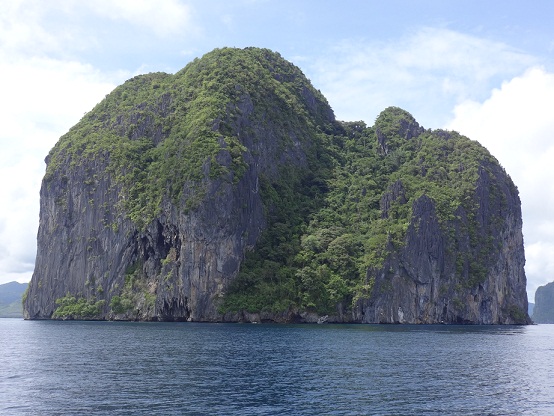
When God blessed the earth, he must have been standing near and facing Palawan because the province is so rich in natural resources and possesses spectacular sceneries – on the ground, underground, on the water, underwater.
In the northern part of Palawan is El Nido, a municipality of almost 40,000 in an area covering 92,326 hectares. The town is named after Swiflets (local name is Balinsasayaw) nests made from the bird’s saliva found in the crevices of the limestone’s cliffs in the area.
The mountain islands of El Nido are simply breathtaking. They are towers of stone so high they almost kiss the clouds.They come in all shapes and forms, depending on your imagination.
If your tour guide is Jayson R. Gonzales of El Bacuit Travel and Tours, he will show you a mountain island shaped like a helicopter, a feature shaped like a king with a crown with a horse nearby, or a stone jutting out of the cliff shaped like the chunky heel of a shoe.
Gonzales will also point out to you Cadlao (Visayan word for laughter), the highest of El Nido’s mountain islands at 640 feet (as high as a 64-floor building). He said Cadlao is the locals’ weather barometer. “When the tip of the mountain is covered by clouds it means it will rain.”
Underwater, El Nido is also as awesome. It’s a coral reef paradise. According to El Nido Foundation Inc.(ENFI) they have identified 447 reef-building coral species in El Nido. There are 44 unconfirmed species.
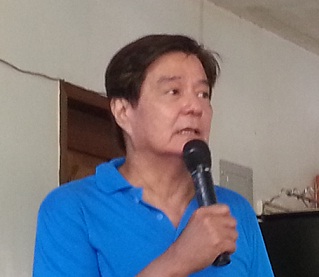
ENFI is working closely with Green Fins,an initiative of the United Nations Environment Programme, for the protection of coral reefs in El Nido. They have just concluded an orientation of journalists on the progress of their efforts in El Nido.
Green Fins, which is coordinated internationally by Reef-World sets the standard for managing the protection of coral reefs. It provides guidance and support for business owners and national authorities to promote best practices in sustainable tourism – especially scuba diving which has become urgent in El Nido with the increase of tourist arrivals.
The importance of coral reefs cannot be overstated: Corals (which are actually animals , not plants or places ) play an essential role in everything from water filtration and fish reproduction to shore line protection and erosion prevention. It also acts as a barrier to storms and surge.
Experts said that if only there were a healthy population of coral reefs in Tacloban during supertyphoon Yolanda, the damage would not have been as calamitous as it was.
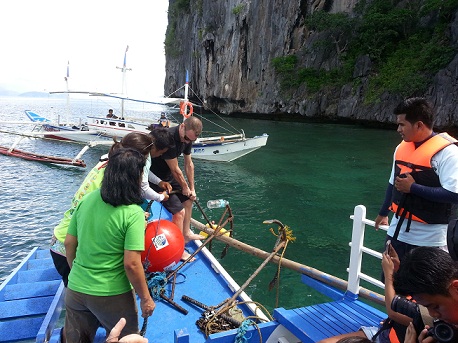
The usual package offered by tour operators island hopping (El Nido has a lot to offer with it placid lagoons and awesome caves. ) which includes scuba diving and snorkeling.
Saying that tourism is both an opportunity and a threat, Irma Rose Marcelo, executive director of ENFI, said some of the tourism-related activities are injurious to coral reefs are anchor damage,snorkeler and diver damage,Boat strike,pollution – solid wastes, eutrophication in ground water from towns, villages and establishments,Sediment run-offs from land clearing, overfishing, and illegal fishing. Climate change, the change of ocean’s temperature is also wreaking havoc on the coral reefs.
Even the fun practice of fish feeding by tourists. Jayson Gonzales said until he trained with ENFI and Green Fins, he didn’t know it. “I even provided bread pieces to tourists to feed the fish so they would come, he said.
Now, at the beginning of the islands tour,“Don’t feed the fish” is one of the “Do’s and Don’ts “ that he gives.
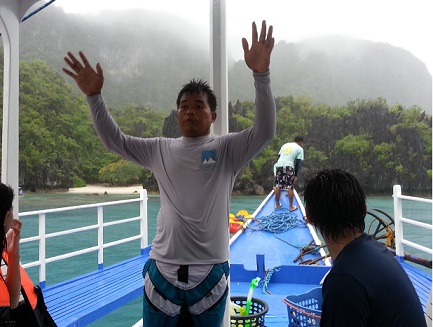
Damaged coral reefs means decreased fish production which could lead to food crisis and malnutrition of the human population.
Marcelo said a 2009 assessment of coral reef condition in El Nido showed coral cover of living hard corals averaged 26 percent which is a fair condition while soft coral cover overall was lower, averaging 4 percent.
As it take hundreds of years for a coral reef to grow, so does rehabilitation of damaged coral reefs. EENFI, which is restoring dynamite-damaged Reefs in Tres Marias islands near the West Philippine Sea, says it’s a very slow process. It takes a year to heal and restore one centimeter of coral reef.
Green Fins believes that diving and snorkeling centers are uniquely positioned to act within their own communities and among customers to encourage positive and lasting change. It’s members are expected to adhere to a Code of Conduct such as No Touching of coral reefs and not anchoring on coral reefs.
Green Fins has also come up with icons on their guidelines so that it would be understood regardless of nationalities.
ENFI’s Charlie Yu recalls the early years when they had the whole island of Shimizu to themselves when they visited Palawan. He said the island now is a favorite picnic area of tourists.
He said being a father, he wants to bequeath to his children an El Nido that may not be as spectacular as he found it but still awesome. “We are doing this for the next generation,” he said.
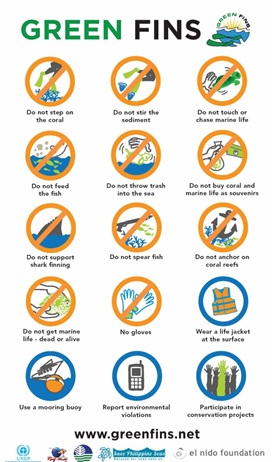
Beautiful Palawan.
I hope El Nido does not go the way of Boracay. The construction of houses in the town proper does not seem to be property regulated. They should limit the height of the houses to just one or two storeys high. And there should be ample setback at the beachfront. During high tide, most of the establishments there become stilt structures.
Ten Knots is a pioneer in tourism-based investments in the country. We were fortunate to be included in their first island resort in El Nido. We supplied the generators and electricity to the resort. Composed mostly of Japan Airlines executives based in Mla. Garden Hotel (now Dusit) they leased the island for 25 years for about P5M (today’s prices run at around P25M for the same size). They even have an Olympic Goldmedalist in swimming (Japanese) as resort manager who has since divested and moved to another resort in Fort Isabelle, in Taytay Palawan. We also installed the electrical system in that island. El Nido has since become the template for high-end resorts worldwide with its cottages on stilts you now see in Malaysia, Indonesia, Maldives, even in the Carribean. The cottages were built in Cagayan and shipped by “Batils” (huge outriggers) to Palawan.
The limestone rock islands are off limits to bird’s nest gatherers during off season and are guarded by Phil. Army soldiers. In the 90s, a sack full of birds nest goes for about P2000. With the competition from Chinese buyers, the price has reached about P10k.
The Chinese should not be allowed anywhere near North Palawan. They have illegally-gathered about 18 square kilometers of live black corals in West Phil. Sea and have transplanted these to Hainan and Guangdong, hoping to force the creation of white sand beaches IN A CENTURY. Fools! The black corals die and are bleached naturally and reduced to sand grains from centuries of pounding by the sea waves. But the natural current from the Pacific will not help them achieve that, ha!